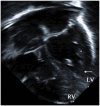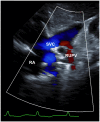Neonatal arrhythmias in Turner syndrome: a case report and review of the literature
- PMID: 34124555
- PMCID: PMC8188870
- DOI: 10.1093/ehjcr/ytab160
Neonatal arrhythmias in Turner syndrome: a case report and review of the literature
Abstract
Background: While left-sided congenital heart defects have been well described in females with Turner syndrome (45, X), the literature is scarce regarding arrhythmias in this patient population.
Case summary: A full-term neonate referred to cardiology was found to have a non-apex forming left ventricle and partial anomalous pulmonary venous return. During the echocardiogram, she developed atrial flutter, followed by orthodromic reentrant supraventricular tachycardia (SVT). She was started on propranolol and eventually switched to sotalol due to breakthrough SVT. A genetics evaluation revealed Turner syndrome with complete monosomy X (45, X). The patient is now 18 months old and has not had any further arrhythmias.
Discussion: We present a rare case of atrial flutter followed by supraventricular tachycardia in a neonate with Turner syndrome and left-sided heart defects. This case highlights the importance of early and precise investigation of cardiac abnormalities in neonatal patients, especially among females with Turner syndrome given their relatively higher risk of cardiovascular disease compared to the general population.
Keywords: Arrhythmia; Atrial flutter; Case report; Congenital heart disease; Supraventricular tachycardia; Turner syndrome.
© The Author(s) 2021. Published by Oxford University Press on behalf of the European Society of Cardiology.
Figures







Similar articles
-
Prenatal diagnosis and management of fetal supraventricular tachyarrhythmia and postnatal outcomes.J Gynecol Obstet Hum Reprod. 2022 Mar;51(3):102323. doi: 10.1016/j.jogoh.2022.102323. Epub 2022 Jan 19. J Gynecol Obstet Hum Reprod. 2022. PMID: 35063720
-
Curing reentrant atrial arrhythmias. Targeting protected zones of slow conduction by catheter ablation.J Electrocardiol. 1993;26 Suppl:194-203. J Electrocardiol. 1993. PMID: 8189124
-
Intravenous flecainide acetate for supraventricular tachycardias.Am J Cardiol. 1988 Aug 25;62(6):16D-22D. doi: 10.1016/0002-9149(88)90496-1. Am J Cardiol. 1988. PMID: 3136630
-
Interventional electrophysiology and its role in the treatment of cardiac arrhythmia.Ann Acad Med Singap. 1998 Mar;27(2):248-54. Ann Acad Med Singap. 1998. PMID: 9663319 Review.
-
[Catheter ablation in supraventricular tachycardia].Z Kardiol. 1996;85 Suppl 6:45-60. Z Kardiol. 1996. PMID: 9064982 Review. German.
Cited by
-
Organ Abnormalities Caused by Turner Syndrome.Cells. 2023 May 11;12(10):1365. doi: 10.3390/cells12101365. Cells. 2023. PMID: 37408200 Free PMC article. Review.
References
-
- Silberbach M, Roos-Hesselink JW, Andersen NH, Braverman AC, Brown N, Collins RT, et al.; On behalf of the American Heart Association Council on Cardiovascular Disease in the Young; Council on Genomic and Precision Medicine; and Council on Peripheral Vascular Disease. Cardiovascular health in turner syndrome: a scientific statement from the American Heart Association. Circ Genom Precis Med 2018;11: 10.1161/HCG.0000000000000048. - DOI - PubMed
-
- Forgosh LB, Conetta DA.. Cardiac assessment in Turner’s syndrome: a case for the inclusion of coronary angiography. J Am Soc Echocardiogr 1992;5:281–284. - PubMed
-
- Turner CJ, Wren C.. The epidemiology of arrhythmia in infants: a population-based study: epidemiology of arrhythmia in infants. J Paediatr Child Health 2013;49:278–281. - PubMed
Publication types
LinkOut - more resources
Full Text Sources
Miscellaneous
